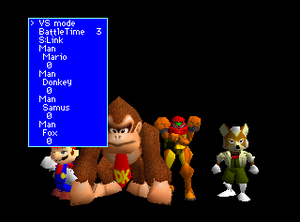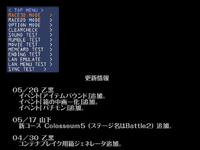Debug menu: Difference between revisions
Serpent King (talk | contribs) |
Serpent King (talk | contribs) (→In Super Smash Bros. Brawl and Super Smash Bros. 4: Don't see the point of this section.) |
||
| Line 43: | Line 43: | ||
*The player can erase data on the Memory Card. | *The player can erase data on the Memory Card. | ||
*Changes can be saved. | *Changes can be saved. | ||
==Trivia== | ==Trivia== | ||
Revision as of 23:22, September 22, 2016
The debug menu is a special menu in Super Smash Bros. and Super Smash Bros. Melee that can be accessed with the use of an Action Replay. The code that accesses the debug menu differs with each version of Melee.
Function
The debug menu was a feature that was used by the developers to test certain aspects in the game, generally as an attempt to prevent glitches or errors from appearing, hence its name of debug. The developers never removed the debug menu from the games, however; as a result, hackers, through the use of devices such as Action Replay, were able to access the menu, as well as give any and all codes relating to the menu.
The debug menu allows a player to do many different things in the game that normally would not be possible, such as gaining access to any character, stage, item, and mode in the game, including those not accessible through normal play. They can also view all the trophies, such as Samus Unmasked, all character endings, and other features, including unused elements. Players can also modify the actual gameplay, such as causing specific items to spawn at any spot, swapping movesets, or modify the Artificial Intelligence of the computer.
Using devices to access the Debug Menu, however, can be risky; the game can crash if the player uses incorrect parameters (such as attempting to play as NONE, winning a game with Master Hand or using AKANEIA as a stage). In the worst cases, the game can cause save games to corrupt in SSB or Melee, or at worst, corrupt the entire card for Melee; as such, it is generally recommended that it is not used with a memory card plugged in, or at least have a backup.
In Super Smash Bros.
In order to get to the debug menu, a GameShark or an emulator must be used.
Combat Debug Includes:
- The player can gain access to any stage, even the ones that are not in the final game, such as Kirby Beta Stage 1 or Kirby Beta Stage 2 and Final Destination.
- The player can gain access to any character, as well as boss characters.
- The player can adjust the damage of each character. (Adjusting damage was not possible in the original game and Melee. In Brawl, one can adjust it via Handicaps).
- The player can make the CPU characters always stop, walk, evade, or attack.
- Changes cannot be saved.
System Debug Includes:
- The player can play all sound effects, including ones not included in the final game, such as (what are presumed to be) Final Smashes.
- The player can test match-end animations, such as a paper airplane.
- The player can watch "New Character Signals" for every character.
- Changes can be saved.
In Super Smash Bros. Melee
In order to get to the debug menu, an Action Replay device must be used.
Features include:
- The player can gain access to any stage, even ones not included in the final game, such as AKANEIA, although many of them crash.
- The player can gain access to any character, including Bosses and even Sandbag.
- The player can make the CPU characters always stop, walk, run, and attack.
- The player can use modes and CPU behaviors used in Events (see below).
- The player can view hitboxes and animation data.
- The player can have an unrestricted camera.
- The player can simulate the results screen.
- The player can erase data on the Memory Card.
- Changes can be saved.
Trivia
- Melee's debug menu continues the music from where the game last was, so it plays the menu music when first entered and no music when entered after the results screen.
- The GameCube game Kirby Air Ride has a debug menu almost exactly like the one in Melee.
- In the Melee debug menu, under MODE TEAM TEST, there are options that have appeared to be named after the game developers (specifically game programmers).
- HANYU from Akio Hanyu.
- OTOGURO from Seiji Otoguro.
- TANIGUTI from Yoshiya Taniguchi (both spellings of "Taniguchi" are acceptable).
- NAGASIMA from Yasuyuki Nagashima (both spellings of "Nagashima" are acceptable).
- KIM from Kim Sung-Kwen.
- SAKUDO from Katsuhiro Sakudo.
- SUGANO from Takayuki Sugano.
- YOSHIKI does not unambiguously correspond to any known game developer, though it is similar to the name of the game designer Yoshiyuki Tagawa.
- Super Smash Bros.'s debug menu contains two voice clips of Ness, one saying "PK" and another saying "Starstorm", as well as another clip of Captain Falcon saying "Come on!" (similarly to the start of his Blue Falcon move), suggesting that Final Smashes were originally intended to appear in the game. Masahiro Sakurai later confirmed in an interview that he did intend to implement Final Smashes in Super Smash Bros., and that the voice clips were intended for that purpose.
See also
External links
| Super Smash Bros. Melee menu items | |
|---|---|
| Vs. Mode | Melee (Time · Stock · Coin Battle · Bonus · Team Battle) · Custom Rules · Special Melee · Tournament Mode · Names |
| 1-P Mode | Regular Match (Classic Mode · All-Star Mode · Adventure Mode) · Event Match · Stadium (Target Test · Home-Run Contest · Multi-Man Melee) · Training |
| Trophies | Gallery · Collection · Lottery |
| Options | Rumble · Sound · Screen Display · Language · Erase Data |
| Data | Snapshots · Melee Records · Sound Test · Archives (NTSC only) · How to Play (PAL only) |
| Unused | Debug menu · Debug sound test menu |

